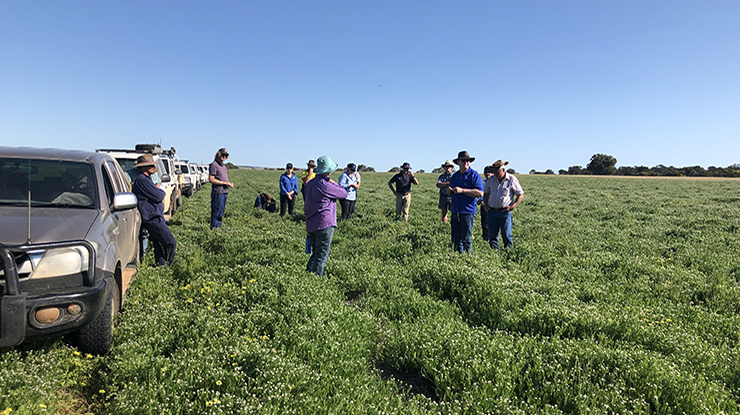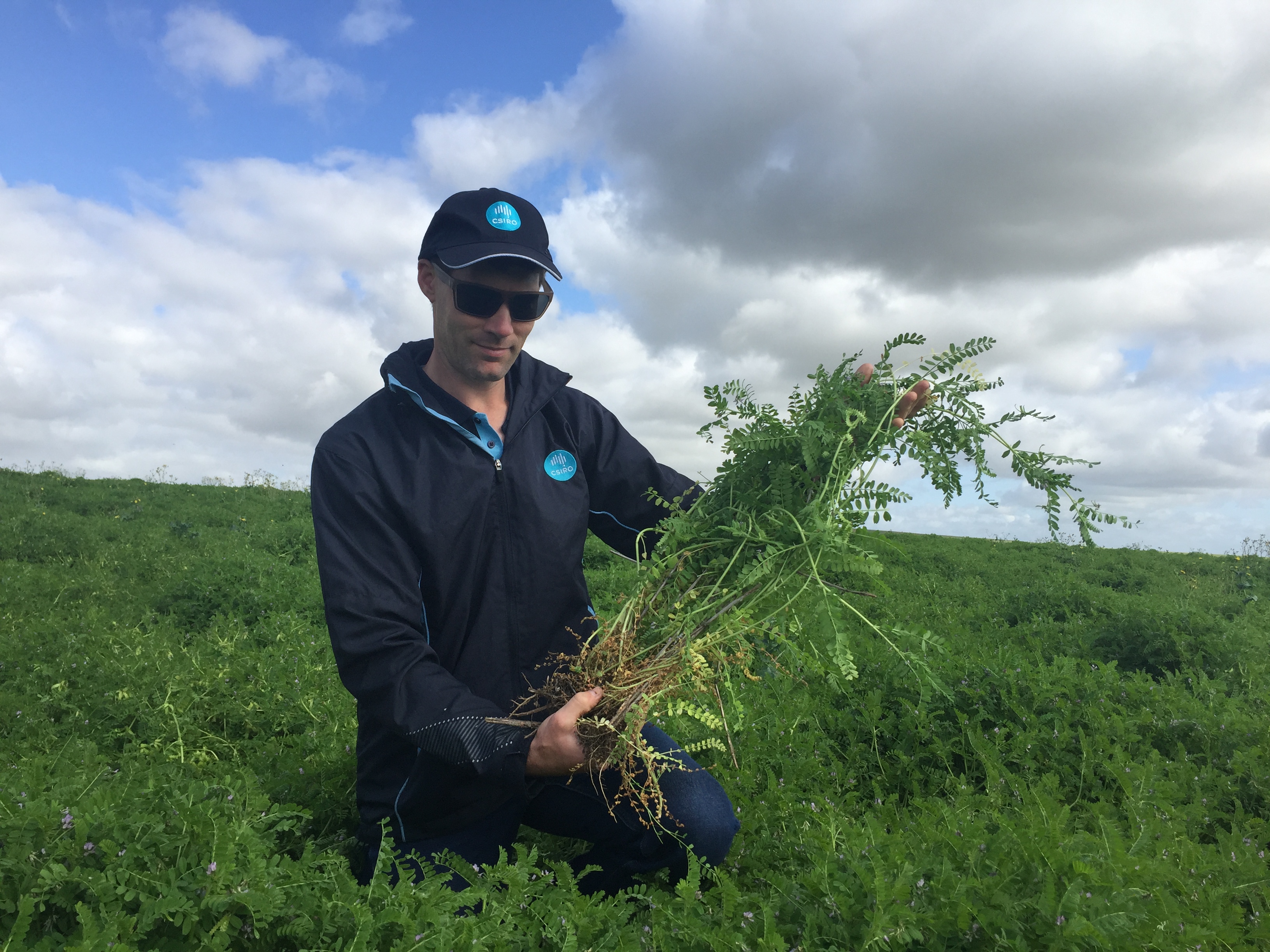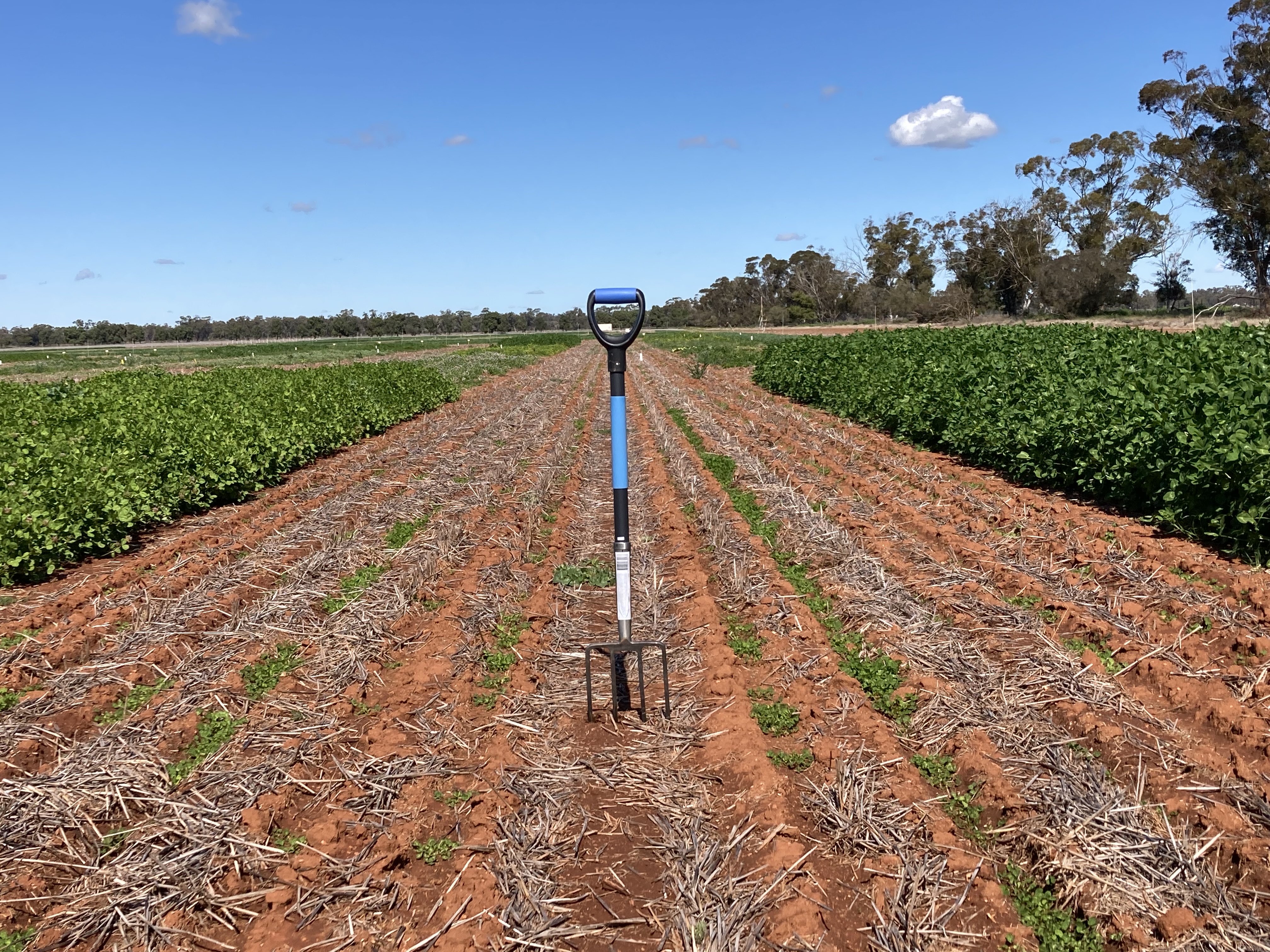 A Dryland Legume Pasture Systems field walk near Dongara, WA, where producers looked at summersown French serradella cv. Margurita pasture. Image: Dean Thomas
A Dryland Legume Pasture Systems field walk near Dongara, WA, where producers looked at summersown French serradella cv. Margurita pasture. Image: Dean Thomas
Southern producers could earn $100 more per winter-grazed hectare by adopting novel hard-seeded pasture legumes.
The Dryland Legume Pasture Systems (DLPS) project investigated new and improved cultivars of pasture legume species (novel legumes) over five years (2017–22) with investment from MLA, the Australian Government Department of Agriculture, Water and the Environment as part of its Rural R&D for Profit program, Grains Research and Development Corporation, and Australian Wool Innovation.
Overcoming challenges
In southern Australian mixed farming systems, pasture phases are necessary in low to medium rainfall zones to support productive livestock and provide optimal crop production.
These are often short-lived annuals which complete their life cycle from winter to early summer.
This can be challenging for producers in these regions due to unreliable rainfall patterns which cause fluctuating legume growth, negatively impacting feed supply and quality for grazing animals.
To combat this challenge, novel hard-seeded legumes have the potential to:
- fill existing nutrient gaps and reduce supplementary feed required for optimum ruminant performance
- maintain or improve livestock productivity through higher growth rates
- provide disease/weed breaks and fix nitrogen for subsequent crops.
Summer sowing
Sowing these novel legume species in summer gives the hard seed time to break down slowly and they are ready to germinate on first rains.
They don't take long to get up and going after rain, and produce more biomass providing more feed for animals, more competition for weeds and more nitrogen for crops.
The novel legume species also produce seed heads at a height above ground which means producers can use a conventional header to harvest their own seed, reducing on-farm costs.
On-farm content

Livestock Systems Scientist, CSIRO Agriculture and Food, Dean Thomas in a productive biserrula cv. Casbah pasture where 10t/ha of biomass was measured. Image: Angelo Loi.
Dr Dean Thomas from CSIRO, a researcher involved in the five-year DLPS project, said improving and introducing novel pasture legumes has unearthed on-farm benefits for producers.
"These novel hard-seeded legumes benefit the whole farming system, through increased profit and reduced financial risk," he said.
"The higher quality feed from novel legumes provides a significant feed advantage for the livestock enterprise, while the pasture legume phase reduced input costs in subsequent crops.
"However, successful legume pasture establishment and high pasture utilisation are required to achieve high profitability from pasture phases."
Tapping into profit
According to Dean, incorporating novel pasture legumes can have a $100/ha increase in profitability compared with continuous cropping rotations.
"The increase in profitability per hectare was through productivity by improving feed quality, but also through reducing financial risk as the novel legumes still proved equally as profitable in poorer seasons," he said.
The project also found that the more producers pushed their stocking rates and utilised the additional pasture grown, the greater that difference in profitability was between improved pasture versus a novel legume pasture.
"We looked at what would happen in these rotations if you established a novel pasture, but then didn't graze it in the first establishment year – on an annualised basis there was about $100/ha difference in profit," Dean said.
"This really reinforced the importance of grazing the novel legumes in the first year."
Reduced input costs
Switching from a traditional legume-based pasture to a novel hard-seeded annual legume pasture can provide producers with the opportunity to decrease costs associated with applying nitrogen to following crops.
"In mixed farming scenarios crops following novel hard-seeded legumes only required a third of the nitrogen inputs, meaning producers purchased less nitrogen," Dean said.
"The nitrogen that's fixed during the pasture phase, even when pastures were grazed, provided enough nitrogen for the subsequent cereal or canola crop – a significant saving in input costs and a real win for these systems."
Six tips for summer sowing novel legumes

The Dryland Legume Pasture Systems research site at Condobolin, NSW, in August 2021 with summer-sown bladder clover on the left, conventionally sown (late May) arrowleaf clover in the middle and summer-sown arrowleaf clover on the right. Image: Belinda Hackney.
There are some important steps to take to get the most out of novel legumes. Here, Dr Belinda Hackney – who managed the NSW component of the DLPS project – shares her top tips for incorporating novel legumes into your pastures system this coming summer.
1. Clean up your weeds
Weed invasion is the leading cause of establishment failure in any new pasture. Take a zero-tolerance approach to weeds in the years leading up to sowing new pastures, and keep fallows and stubbles clean.
2. Check your herbicide labels
Be sure to check the labels of all herbicides used in the years leading up to pasture sowing (don't forget herbicides used to control summer weeds) to meet the requirements for safe plant-back periods. Remember, you're going to be sowing five months ahead of when you conventionally would be.
3. Choose the right novel legume species
The project found there were differences in the species and cultivars that could be used in NSW compared with other states, such as WA. Species also vary in their tolerance to specific soil conditions such as pH and drainage., so do your research to find out what species performs best in your region.
4. Sow at the right time, rate, depth and the right form of seed
The best results occur when unprocessed seed (bare-seeded species) or pod segments (serradella) of suitable species and varieties for your region are sown in mid to late summer. Minimum seeding rates are 12kg/ha for bare-seeded species and 20kg/ha for serradella pod. Seed and pod segments need to be sown at a depth of 10mm. Placing seed too deep will result in significantly lower emergence.
5. Start with a nursery paddock
A nursey paddock of between 10–80ha is a good way to test the water without having to commit to something that you've never grown before. Remember, seed of these species can be harvested using a header, so you can quickly scale up seed supply to enable renovation of larger areas.
6. Manage the paddock in the establishment year for seed set
The priority in the establishment year is to achieve adequate seed set, as this is the cornerstone of building a seedbank for future regeneration. In dry years, this may mean minimal grazing in the establishment year. In wet years, paddocks need to be grazed for prolonged periods to control the large quantities of herbage (in some cases up to 8t DM/ha by the end of winter).
To do:
- Visit MLA's legumes resource hub at com.au/legumes
- Watch a video showing the difference in herbage availability of summer sowing of legumes versus conventional sowing.
- Watch a video with producers who have planted novel legumes.
- Read MLA's fact sheets:






